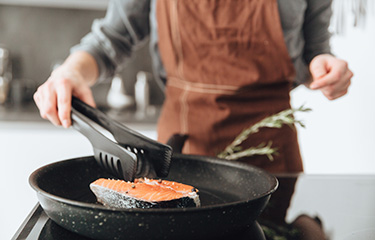Experts discuss the best ways to boost US seafood consumption

U.S. government experts and seafood industry insiders discussed the best ways to boost U.S. seafood consumption at the Seafood Nutrition Partnership’s State of the Science Symposium in Washington, D.C. on 22 September.
Between 2012 and 2020, U.S. per-capita seafood consumption rose from 16.8 pounds 19 pounds – and with a U.S. dietary guideline of 26 pounds per capita, there are more gains to be had, SNP President Linda Cornish said.
“It’s a simple message: Seafood is good for our public health … planet health, and our future food security,” Cornish said. “We are going to have 9 to 10 billion people by 2050 and, with our land-based agriculture, we are maxed out o freshn water resource and arable land. We have to look to our oceans and, in concert with that, we need to help Americans change their behavior and adopt a seafood-rich diet.”
But Cornish said upping U.S. seafood consumption will take a concerted campaign armed with dedicated funding, along with a collaborative effort from those in government, on the supply side, and in retail and foodservice. The movement to create a National Seafood Council will be key in this effort, Cornish said. The U.S. Senate Appropriations Subcommittee on Commerce, Justice, Science, and Related Agencies recently released an explanatory statement on a bill heading to the U.S. Senate that includes a specific order to begin pursuing a National Seafood Council. A specific order in the 222-page document directs NOAA to begin detailing how it facilitate such a council.
Also speaking at the symposium, NOAA Fisheries Deputy Assistant Administrator for Operations Paul Doremus said the two major drivers of American seafood consumption will be the health and sustainability attributes of seafood.
“We can ensure the sustainability of that supply; We set the global standard for how to do that … that’s a source of certainty for people who are concerned about what they are purchasing is sustainable,” Doremus said. “If we are going to be successful in this campaign – increasing per capita consumption – we have to think about where is the seafood going to come from?”
Doremus said the marketing push should be comprehensive, including both imported and domestic seafood, and wild-caught and farm-raised products. That inclusive approach might be difficult in the fiercely competitive seafood industry, but will be compulsory if the marketing program is to be successful, Doremus said
“It takes a network approach to getting the word out. It is growing organic demand, but also ensuring we have sustainable supply,” he said. “We are focusing today on health benefits … and the aggregate economic benefits are extraordinary. We have to pull it together so we have good sustainable supply and so Americans know seafood is good for their health.”
Maya Maroto, the vice president of consulting and communications firm FoodMinds, called on the U.S. government to do its part by better promoting seafood as beneficial to Americans’ health, the way it does for produce. Seafood can address the U.S. Department of Agriculture’s prioritization of nutrition security – the value of food in maintaining and restoring health – over the more general term of food insecurity, but despite that, seafood is still marginalized in federal buying programs. Maroto said.
Currently, in the USDA’s National School Lunch Program, seafood is not a “required element,” as vegetables, fruits, and grains are, Maroto said. The Women, Infants, and Children (WIC) federal nutrition program allows recipients to purchase canned tuna, salmon, and mackerel, but not other species or forms of seafood, such as fresh or frozen – though WIC recipients can buy all vegetables whether frozen, canned, or fresh.
And seafood is not included in the USDA’s Gus Schumacher Nutrition Incentive Program, a grant program for fiscal years 2019 through 2023 that allows income-eligible consumers to purchase fruits and vegetables via prescriptions from their healthcare providers.
“There is a lot of room to grow in our federal nutrition programs in how they are supporting people. When you look at mental health disparities … it is really starkly divided among racial and income lines. What would happen if we doubled people’s ability to buy seafood? We know that seafood can be expensive,” Maroto said.
The Dietary Guidelines for Americans recommend eating at least 8 ounces of seafood per week, but 90 percent of Americans are not doing so, Maroto said.
“The [DGA] guidelines are not being mirrored in our federal guidelines,” Maroto said. “The goal is that we establish seafood as nutrition security programs.”
Seafood purchases make up only 3 percent of spending in the USDA’s Agriculture Marketing Service purchases of commodities that are distributed to food banks, Indian reservations, schools, and other nutrition programs, Maroto said.
“We are not putting our money where our mouth is when it comes to including seafood,” Maroto said.
Photo courtesy of Dean Drobot/Shutterstock






Share